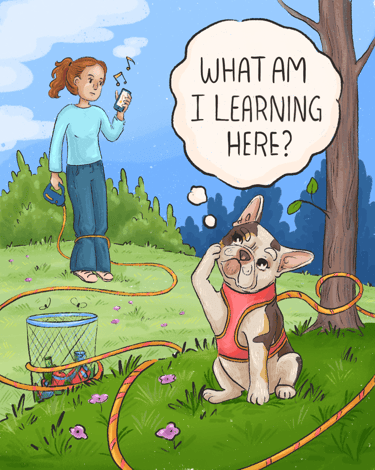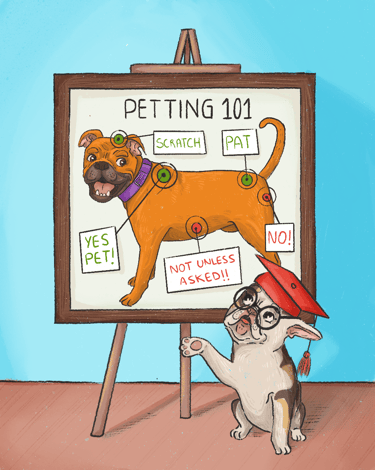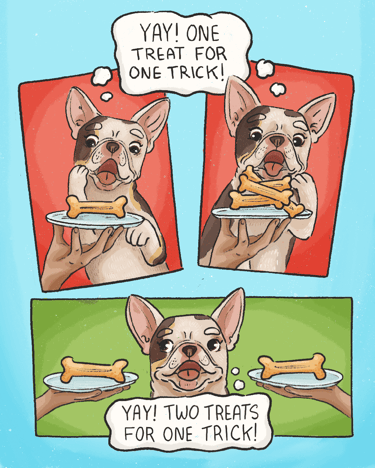It's important that we understand the basics of what we are doing, so in this chapter we will go through the key principles that make up the Conker’s Club way as well as the foundation of rewarding and correcting. We believe in an extremely positive but balanced approach, which means that corrections are needed- but only using appropriate methods which do not cause any harm, and which lead to more positive behaviours which we can reward.
These principles allow our dogs to understand us. If you are having difficulty with a behaviour, you can run through the questions below to troubleshoot the situation quickly.
Ask yourself-
Am I cool, calm and in control of myself?
Have I set us up to succeed?
Am I being consistent with my corrections, and ending on a reward for good behaviour?
What am I teaching them at this moment?
Do I have something positive to redirect to?
1.
Before you train your dog, you have to train yourself. Dogs respond to your energy, tone of voice and body language so being in control of these things means you will have control of the situation. Check your emotions, take a deep breath and remind yourself that you are able to change whatever is happening. Reacting quickly out of anger or frustration leads to you making choices that damage your relationship, and just a reminder here that striking an animal is never acceptable in any situation. Pain and fear are not training tools.
2.
Setting you and your dog up to succeed means not making leaps before you are ready. For example, a dog which is not house trained that has been left alone with a full bladder has been set up to make the wrong choice and who could blame them? We are responsible for our dog's behaviour- if they aren't doing what we want them to do, then we have work to do. Your dog has physical, mental, emotional and social needs, and if you don't meet them then that is when mistakes happen.
3.
We will go into more detail about how to give appropriate corrections later, but the key thing to remember here is consistency. Your “no” doesn't mean anything to your dog if it is sometimes a yes. This is a big part of the trust in your relationship, because you are showing that you mean what you say and that they can rely on you. If they are unsure, then they may well just make their own minds up based on what feels good in the moment. The second part of this question is about always ending on a reward- this is explained further in chapter 2!
4.
Every time you interact with your dog, they are learning something from you. Is it the thing that you want them to learn? It is up to you to control what you are teaching them with your actions and reactions, in every moment of every day. This is what we mean when we say that training is never over, and isn’t something that you can do a half-hour session of once a week and expect good results. You must show your dog compassionate leadership at all times, and be in constant communication with them.
5.
Redirecting means getting them to start doing something you want them to do and praising that, which shows the dog what they are supposed to be doing and what will make you happy. This turns every “‘mistake” into a chance to learn how to do the right thing. For Conker, this is almost always chewing his bones- he has them littered around the house so that we always have a good behaviour to redirect him to. You will need to mark this behaviour with a lot of treats and praise so that it becomes higher value than barking out of the window! Remember, if your dog doesn’t have something to do, they will find something to do.
Foundations
Beating yourself up
We have all had a bad walk or training session that just doesn't go the way you want it to.
It's about working towards bad sessions just being sessions where you had to adjust how you were doing things.
No matter what, you have learned something and your task once you’ve cooled off is to analyse the event so that you can both make better choices next time.
Conker's Don'ts


There are a lot of norms within keeping a dog that people just accept but actually don't work with training, so we have put a few below.
Squeaky Toys
We understand that your dog may enjoy them but small animals and children squeak at times too, so we don't want to encourage biting to the sound of a squeak!
The reason they like the toy is the stimulation/reward. We need to replace that with chewing an appropriate toy/bone and working on our praise being enough of a reward in itself.
Instead, use a crunchy ball. These are balls that usually have something inside to make a crinkle sound when they bite them, so they still get the secondary stimulation without the negatives that come from the squeak.
Any corrective tool that relies on pain or fear
Prong collars are usually made of metal and have spikes along the inside that are always in contact with your dog's skin. When you correct with this tool, the idea is to make the collar smaller like a slip lead or martingale collar. Where prongs are different to slips are that this causes the spikes to press into the skin making the dog associate the action they are doing with pain.
Shock collars are used to deliver an electric shock to the dog. As with the prong it is used as a corrective tool, but we feel it needs to be avoided because the communication you are sending is that the behaviour will cause pain which creates fear.
Shock collars are not to be confused with E-Collars that vibrate when a button is pressed. Although we don’t use these we do acknowledge that they are different and don’t rely on pain, but instead a strong vibration to break them from a distraction.
Striking an animal is never okay, there is never a situation that requires you to hurt your animal. It will cause major setbacks in the relationship you are working on building.
Unsuitable chew toys and treats
Letting your dog chew on rope toys, for example, which can lead to string tangling up in their guts. Have a play then put it away, and replace it with a safe toy designed for chewing.
Rawhide can be full of harmful bacteria as well as leading to impaction of the gut.
People food
Giving them the foods we eat can cause behavioural, weight and digestion issues or in the worst cases be toxic and lead to death.
There needs to be very clear boundaries around what is your food and theirs, because the simpler the rules are the easier it is for the dog to understand them. This will help with leadership.
Ignoring
In our puppy guide, we will show you how to use ignoring as a tool (as your attention is a reward which we use to encourage positive behaviours) but in older dogs just ignoring them isn't going to help your relationship.
In rescue dogs it can be detrimental, as with the fear and pain sections above. A lack of attention is something they have likely had a lot of stress over if they were abandoned or if they were kept in kennels for an extended period, so creating a sense of security with you as their leader is vital.
If we have done our jobs right, they are barking to communicate something to you. It is then your job to understand what they need and get them back to being settled- happy, empty, fed and watered.
Escalation
We need to avoid making a correction into a confrontation. We do this by taking control of the situation. It is easier said than done, but we will give you the tools later in this guide.
Strong posture will help to ensure they don’t see you as matching their energy, but changing it.
Extending leads
These make your walks easier earlier, but they teach your dog that if they want freedom then they have to pull to get it.
It is better in the long term to use two separate leads-
Standard lead for close control
Long line so they can have some freedom while still under control. The added benefit is that we can use this to build up your recall training to the point that the long line is no longer needed. But remember, we don't walk before we can run- we don’t let a dog off lead until we are 100% sure of their recall.
Balanced training is a term that can lead to confusion, so we want to outline what we mean. Corrections are only to be used when appropriate and never to cause fear or pain, but to distract them from what they are doing. This gives you the opportunity to go into your positive encouragement, which will ‘shape’ whatever behaviour is a more appropriate one for the situation. Balanced doesn't mean 50/50 reward/correction. Once the communication has been learnt, it should be much more like 90/10 on the positive side. It sounds miserable to be correcting a dog any more than that.
Have you ever taught your dog what yes and no mean? We can take these basics for granted because we assume that they understand, but in a dog's mind there can be a lot of confusion as their world is so much simpler than ours. The next sections cover rewards and corrections, which are the ways that your dog will be able to understand what yes and no mean.
By marking the word “yes” with rewards that make your dog really happy, you make the connection that this means whatever they are doing is brilliant and that they should do it all the time! We will show you how to do this in our section on marked words.
By consistently interrupting unwanted behaviour with your “no”, you show your dog that whatever they were doing wasn't okay and that you, as their leader, are someone they listen to. Then by consistently redirecting to something that you can praise them for, you show them how to make everyone in the room happy which is all a dog really wants.
This is how we develop a language that you can both speak- by giving clear, consistent feedback about whatever they are doing.
Yes and No Feedback
Physical praise
Stroke
Pet
Scritch
Squish their little faces
Depending on the size of your dog, give them a good pat on the side
Play
Tug toys are a great way to let off steam after an engaged session
Fetch is a favourite of Conker, he loves getting to run head first at his ball.
Toys
Your dog should always have access to a chew toy. They will self soothe by chewing because the action of chewing releases the happy hormones for them.
Interactive toys are what you use for play or training and should only be used when supervised or as part of an exercise. An example would be your tug toy, if it is left out in the same way as a chew toy it will lose the distinction which can lead to them always wanting to ‘fight you for it’ and then guarding behaviours.
Food loaded toys not only give them the food reward but also the mental stimulation of getting the food out. It can also help with crate training and encouraging separation.
A kong shaped toy filled with a mixture of their dry kibble and water and then frozen
Specially made toys and treats that fit into each other can be brought for convenience
Rewards


Once the foundations are built you will find a natural balance in how much you are rewarding through the day with food. The higher value treats will lose novelty if used daily, so be mindful of this. Eventually the goal is to communicate well by just using some of their daily dry kibble as well as verbal praise 90% of the time. This doesn't mean that you don't use the others, it's just that you use them when doing something that requires an extra gear of concentration.


Food
This can be as simple as their dry kibble. (1 piece of kibble = 1 reward, 4 pieces of kibble at once = 1 reward, 4 pieces given 1 at a time = 4 rewards.)
Higher value treats can come in many forms but some examples
Dry kibble dipped in peanut butter (anything dipped in peanut butter works)
Chews, we look go for one ingredient or as few as possible
Training pastes, convenient way to have a big reward on hand
Vocal praise
Marked words to confirm what they are doing is right
If you dog is ignoring these it means they need to be ‘charged’




